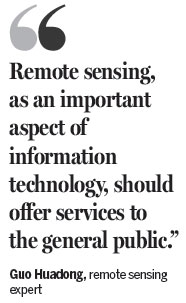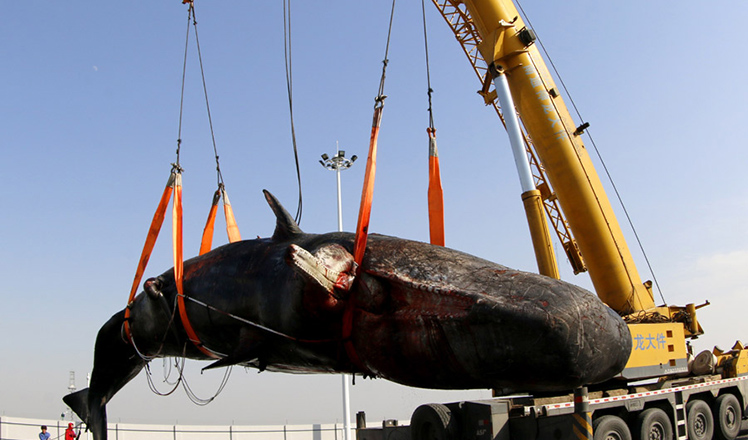Resort island turns to remote sensing
Updated: 2016-02-18 08:30
By Cheng Yingqi in Sanya, Hainan(China Daily)
|
||||||||
Sanya, one of the most famous holiday paradises in South China's Hainan province, is poised to evolve into a hub for the remote sensing industry.
"In the past, remote sensing technologies were applied mainly in monitoring resources, environmental changes and natural disasters. Now, it is time to commercialize remote sensing information to serve more people," said Guo Huadong, a remote sensing expert and a member of the Chinese Academy of Sciences.
"Remote sensing, as an important aspect of information technology, should offer services to the general public," Guo said.
The academy's Institute of Remote Sensing and Digital Earth has agreed to construct a remote-sensing industrial park in Sanya in cooperation with the Hainan provincial government. If everything goes smoothly, construction will start in March.
Remote sensing - the use of airborne and spaceborne technologies to detect objects on the land, in the atmosphere or in the oceans - can be put to many uses.

"We can expand the use of remote sensing to the mobile Internet, say, mobile mapping with remote sensing information. But all of this requires the participation of the business sector," said Liu Yongwei, director of the Sanya Institute of Remote Sensing.
When complete, the 20-hectare industrial park will provide space for 30 remote sensing companies.
"A number of companies affiliated to the Chinese Academy of Sciences have shown interest in coming here," Liu said. "If each company generates 100 million yuan ($15.2 million) in production value every year, the output of the whole industry park will be close to 10 percent of Sanya's GDP."
One of the advantages of the remote sensing industrial park is the broad coverage of satellite signals it could receive as part of a nationwide ground station network.
Since the 1980s, the Institute of Remote Sensing and Digital Earth has built three satellite ground stations - in Beijing, the Xinjiang Uygur autonomous region and Sanya - which coordinate with each other to oversee 70 percent of the land and sea area in Asia.
In 2017, a ground station under construction in the Arctic is also expected to be completed, which will be linked to the network.
"We have to ensure that we get ahold of enough space information to the furthest extent of our national interests," said Guo. All the information is shared for professional and general use.
"The Chinese Academy of Sciences has produced more than 80 percent of the satellite sensors in China. In the future, I also hope the Sanya industrial park will become a production base for commercial satellites," he said.
chengyingqi@chinadaily.com.cn
(China Daily 02/18/2016 page5)
- One of the two dead sperm whales in East China salvaged
- Paid menstrual leave provokes controversy in China
- MIT establishes supply chain education center in China
- 20,000 yuan eaten by ants gives artist a frame for inspiration
- Chinese military sets up corruption hotline
- Foreigners working in Beijing can now buy apartments immediately
- 'Grim Sleeper' murder trial begins six years after arrest
- Cameron defends EU deal as lawmakers offer no guarantees
- Sarkozy placed under investigation in campaign funding probe
- Moscow dismisses accusation of Russia bombing Syrian hospitals
- 2016 Westminster Kennel Club Dog Show held in New York
- Pakistan confirms participation in Saudi-led military drills

 One of the two dead sperm whales in East China salvaged
One of the two dead sperm whales in East China salvaged
 Armless student pursues painting dream
Armless student pursues painting dream
 62-year-old folk artist carries on firecracker dragon lantern
62-year-old folk artist carries on firecracker dragon lantern
 Bridge expert's former home converted to restaurant
Bridge expert's former home converted to restaurant
 Excitement, charm and grace: Chinese New Year in UK
Excitement, charm and grace: Chinese New Year in UK
 Taylor Swift wins Album of the Year at Grammys
Taylor Swift wins Album of the Year at Grammys
 Stars spotted at film academy exam in China
Stars spotted at film academy exam in China
 Record number of Chinese travel abroad for Spring Festival
Record number of Chinese travel abroad for Spring Festival
Most Viewed
Editor's Picks

|

|

|

|

|

|
Today's Top News
Will US-ASEAN meeting be good for region?
Accentuate the positive in Sino-US relations
Dangerous games on peninsula will have no winner
National Art Museum showing 400 puppets in new exhibition
Finest Chinese porcelains expected to fetch over $28 million
Monkey portraits by Chinese ink painting masters
Beijing's movie fans in for new experience
Obama to deliver final State of the Union speech
US Weekly

|

|








